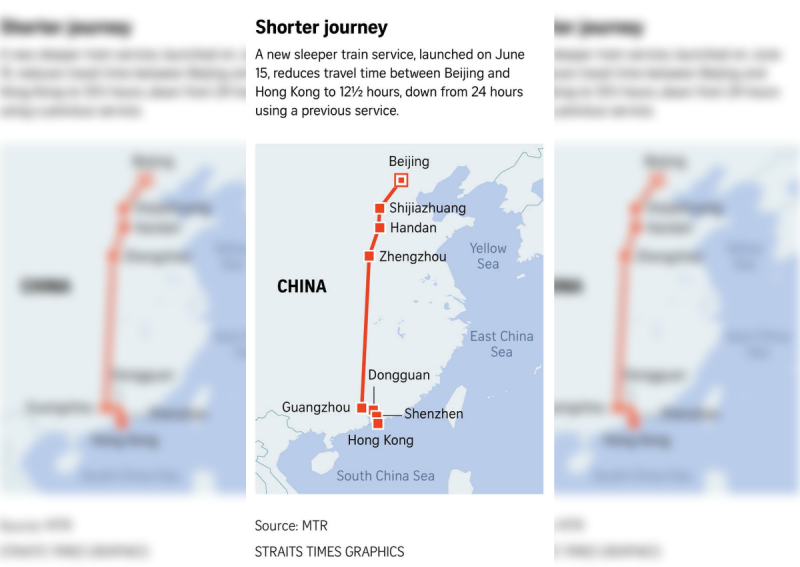What it is like on board the new sleeper train from Beijing to Hong Kong


BEIJING - The melodic cadence of Cantonese was ringing throughout Waiting Hall 13 of the Beijing West Railway Station on the evening of June 21 as passengers waited to board the new sleeper train to Hong Kong.
Train services from Hong Kong to Beijing and Shanghai, which were suspended during the Covid-19 pandemic in 2020, resumed on June 15 with sleeper trains introduced to the Special Administrative Region (SAR).
It brings Hong Kong in line with mainland China, where sleeper trains are a common and popular way to travel between provinces.
With the new sleeper service, travel time between the two cities has also been almost halved, from 24 hours to 12 hours and 34 minutes, as China's second-fastest train - the Dongche, with an average speed of 250kmh - replaced the older ones.
Operated by both China Railways and Hong Kong's MTR Corporation, the sleeper service can take about 600 passengers each way. It runs from Fridays to Mondays.
The upgrade is part of Beijing's drive to further integrate Hong Kong with the mainland.
Recently, eight growing Chinese cities, such as Taiyuan in Shanxi province, Harbin in Heilongjiang and Lanzhou in Gansu, have been included in Hong Kong's solo traveller scheme.
The change, which kicked in on May 27, will allow residents in these cities to visit Hong Kong without having to join a tour group.
Passengers who have already travelled between Beijing and Hong Kong on the new sleeper trains told The Straits Times that the experience was comfortable, even as they made suggestions for improvements.
Sales manager Xu Yao, 30, who was travelling with her husband and their four-year-old son from Beijing on June 21, said she had wanted to try out the train after reading about it in the news.
The family, who live in Hebei province and could have boarded the train there, had come to neighbouring Beijing just so they could take the new service for its entire journey.
Retiree Rosa Ng said it was her first time on a sleeper train when she took the service from Beijing to Hong Kong on June 29.
The Hong Kong resident had spent the earlier part of the week visiting Beijing with her husband. Being on the train "was a good experience and very convenient", said Mrs Ng, who is in her 60s.

"You take your dinner, go to sleep, wake up, and you've arrived at your destination," she added.
She preferred taking the sleeper train to flying - which would take about 3½ hours - as she does not like being "confined to a seat" due to joint pain. "But it would have been even better if the sleeper berths were more spacious, with the beds farther apart from one another," Mrs Ng said.
When ST took the 8.13pm sleeper train from Beijing to Hong Kong on June 21, there were no curtains for the beds, which meant privacy was a privilege.
Space was tight. ST's China correspondent Aw Cheng Wei is about 1.7m tall, but with a backpack at the foot of the bed, there was no space for his legs.
Still, there were nice touches in the cabin, including faux magnolia flowers on the common table. Plastic planters dotted the toilet, sinks and dining cabin as well. Air-conditioning and lights in the cabin can be adjusted.
Two meals - dinner and breakfast the next day, such as bread and bottled water - were also delivered to the beds by train staff. The meals were included in the ticket price.
Retirees from Hong Kong made up most of the passengers.
Madam Xu was annoyed by the lack of power sockets in the cabins - there was only one socket in each cabin that sleeps four.
More sockets are available, though, along the common corridor outside each cabin.
Besides the Hong Kong-Beijing service, a similar one that runs between the SAR and Shanghai was also launched on June 15, replacing the previous 24-hour service that was suspended during the pandemic as well.
Demand for sleeper train tickets between Beijing and Hong Kong appears to have cooled off since the new service's opening weekend, when tickets were sold out.
Checks over the previous weekend by ST showed that tickets were still available a day before departure in both Hong Kong and Beijing.
A ticket for the sleeper service from Beijing to Hong Kong on June 21 cost 1,170 yuan (S$220).
Plane tickets cost between 1,800 and 2,500 yuan for one way that weekend, with the journey taking about 3½ hours each way.

Hong Kong's MTR Corporation said in an e-mail response to ST that operations have been smooth since the launch of the sleeper trains, but declined to comment on demand projection and the passenger load so far.
A call operator for China Railways told ST that the state-owned enterprise does not take press queries.
Before the pandemic, tickets for the previous service used to be sold out during major holidays in mainland China such as National Day and Labour Day.
App developer Li Youjing, 28, who lives in Beijing, expects to take the train before the year ends to pick up Steam Deck, a game console that is available in Hong Kong but not mainland China.
[[nid:615822]]
"I don't like flying, so I wasn't inclined to take a plane just to spend a weekend there and pick up the game console," said Mr Li.
He said of the sleeper service: "I like how we can reach Hong Kong in the morning and start sightseeing or shopping right away, since West Kowloon is near the city centre." The terminal for the service is in West Kowloon.
"Taking the sleeper train on Friday and coming back to Beijing on Sunday sounds like a nice weekend trip, which is enough to see Hong Kong," he added.
This article was first published in The Straits Times. Permission required for reproduction.